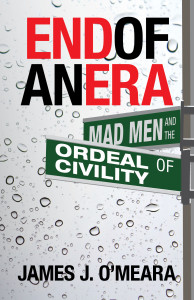Horses and Heavy Hors d’Oeuvres
Gordon Peter Wilson
The Prophets of Gentilly Terrace: A New Orleans Novel
Austin, Tex.: Greenleaf Publishing Group, 2023
The idea was a selfish one, and it felt a lot like blackmail, but it was an opportunity to solve everyone’s problems. Such a sensitive matter required all of the diplomatic skills he had honed over the years as Burton Clayton’s bagman.
I greeted Gordon Peter Wilson’s first, previous, novel with enthusiasm, and that enthusiasm continues with this latest one.[1]
Prophets is a “Right-wing” novel in the best sense: Its characters aren’t constantly-online losers who only take a break from rants and talking points to do some target practice to prepare for the day — it’s coming soon! — when the normies will all pay. It has real people as its subject, with real problems, but it’s not afraid to talk about race, class, politics and heritage. Let’s meet them!
Jeremiah “Jerry” Sonthonax is a slice of Southern-fried Saul Goodman, a lawyer on probation — for stealing client funds — driving around in a beater car with a burner phone and a Bluetooth headset. He has alimony and child support weighing him down, along with a taste for gambling on the ponies, and his new job as one of the seven elected tax assessors of New Orleans Parish isn’t as lucrative or prestigious as he thought it would be: He’s assigned the low-rent New Orleans East district, mostly convenience stores and the like, run by hard-working but impecunious Vietnamese immigrants.
And like everyone else in New Orleans, he’s practically royalty!
He liked to think that his aristocratic French Catholic last name would have been proof enough of his membership in the ruling Black political class of New Orleans such as to attract palm greasers with full briefcases to the back door of his assessor’s office. For God’s sake! I am a Sonthonax!
His paternal grandmother, a deeply French and pious Catholic matriarch who descended from a free Black family from the French colony formerly known as Saint-Domingue. Her husband, Jerry’s grandfather, was also a direct descendant of nineteenth-century refugees from Saint-Domingue named Sonthonax, mixed-race free people of color who had fled the island and their sugar plantation with as many of their dark-skinned slaves as they could take with them. The family patriarch, Étienne de Bizefranc Sonthonax, found refuge in the early 1800s in New Orleans, a French speaking territory of an adolescent United States that had retained all its French customs, even after Emperor Napoleon sold the city and the rest of Louisiana to raise funds for the wars of empire. It was also one of the reasons Jerry had such light skin.
The other reason had an even more aristocratic origin—one that linked Jerry directly to France without an intermediate layover in a Caribbean French colony. Jerry’s grandmother was herself a light-skinned Creole whose origins could be traced back to one of the oldest and most distinguished White families of eighteenth-century New Orleans — the Durels.
I quote this at some length because such ties of blood and real estate are very much part of the fabric of this narrative.
Anyway, after losing another badly needed $600 at the Off Track Betting parlor, the same Vietnamese guy who gave him the bum tip accidentally provides some information that might be more useful: a convenience store in Jerry’s tax district seems to be selling something more lucrative than Regal and pull-tabs.
But a newly-elected assessor and downwardly-mobile shyster needs more juice even to muscle a Vietnamese store clerk. First, he needs Glenn Hornacek:
His official title was president of Parallax Consulting, ostensibly a real estate and property development consulting firm that assisted and advised commercial investors from outside of New Orleans who inevitably encountered the impediments of permitting, taxation, and minority set-aside regulations that City Hall imposed.
In reality, Parallax Consulting was a one-man shop that liaised with a variety of elected city officials for a fee — one that would be passed on, in part, to the very politicians whose approval could be bought. Disguised payola was distasteful and perhaps illegal, but it was an impurity unsmeltable from the system it contaminated. It was realpolitik at its most venal.
The final component of this public-private transaction was easy to predict. Parallax Consulting would then make the proceeds of the consulting service available to Burton Clayton through various means, including campaign contributions to Clayton and his political allies, investments in shell corporations controlled by Clayton, gifts to Clayton family members, luxury car lease payments for vehicles to be used by Clayton as he saw fit, and donations to any other pet projects Clayton supervised in his quasi-public empire.
Unlike Jerry, Glenn is a white newcomer to New Orleans, but also unlike Jerry, he’s found a way to ingratiate himself into the upper class:
Membership in the impermeable social amnion of White New Orleans was utterly out of his reach, in spite of the fact that he had money. Any other Southern city would welcome a resourceful entrepreneur like him into prominent social circles, but not here. It took decades, or even centuries, to overcome the stigma of New Wealth. And so, he would get even by ingratiating himself with powerful Black city officials like Burton Clayton. It may not have been his first choice, but he took to his role as the adopted mascot of the Black political class with great gusto. It was a delicious reprisal: Clayton would first gig rich White businessmen with predatory assessments on their real estate, and Glenn would then swoop in with promises that those assessments could be reconsidered if a reasonable consulting fee were paid. The two were conjoined parts of an extortion racket that brought a certain spiteful satisfaction as well as a steady income to both men.
To keep in Burton’s good graces, he needs the right house in the right neighborhood: the titular Gentilly Terrace:
Known for its quaint, polyethnic shabbiness and working-class grit, Gentilly had begun as a bedroom community of Arts and Crafts bungalows for middle-class professionals seeking a more modern suburban lifestyle back in the 1920s.
More recently, Gentilly had become a neighborhood adopted by enlightened and romantic White interlopers keen to cultivate a certain romantic identity: an open rejection of the bourgeois predictability of the bland way of life that prevailed in the exclusively White suburbs of Jefferson Parish.
Gentilly was home to the New Orleans Fair Grounds Race Course, where the New Orleans Jazz & Heritage Festival was held and where the artistic and the avant-garde flocked to express their contempt for the dullard and the doctrinaire, the boring and the banal, the milquetoast and the marionette, simply by living there. It was frontier living, to be sure, inasmuch as it was close to some of the more dangerous ghettoes of the city, but there was enough residential stability for White progressives to make a statement about tolerance and race-mixing.
Thus would Glenn Hornacek, late of St. Louis, be reborn as a “Big Easian” or “super-native,” one of the “network of out-of-town settlers in search of historic, even neglected, housing stock where they could renovate dilapidated property, set up housekeeping, and enjoy the conveniences of urban living without paying the premium prices fetched in the already-established areas of town”:
Like Alexander’s generals in Egypt, he was going native. If Glenn were to be truly authentic — a simon-pure denizen of a back-a-town borghetto — he would have to affect an easy familiarity with installation art shows in Tremé, experimental theater in St. Roch, and late-night Yaka-mein bowlfuls in the Bywater (things only people like Bob Dylan and Anthony Bourdain would discover in their deepest chthonic expeditions).
For too long, aloof White New Orleans had failed to appreciate the cultural pricelessness of the Afro-Caribbean ancestral spontaneity such gatherings evinced. Glenn wanted very much to be known, particularly by Burton Clayton, as an enthusiastic participant in the campaign to preserve the rituals of authentic Black self-expression.
And it’s not just culture:
He also found time to show his belief in the political movements that Burton supported and the progressive causes Burton’s constituency responded to — things like sleeping under the overpass to raise awareness for the homeless, keeping a compost heap outside his kitchen window, fighting against the evils of fracking and fossil fuels, shopping at the Saturday morning locavore farmer’s market, plunking souvenir tambourines alongside ethno-activists at outdoor Afro-Cuban music concerts, picketing for safer bicycle lanes, and generally adopting every righteous appeal to philodemic virtue he could sign up for. Though none of these gatherings ever made direct demands for increased taxes or expanded governmental administration of the funds those taxes would generate, the socialistic messaging was clear enough for Burton’s voters to understand. They might be indifferent to the environmental benefits of electric cars and solar panels, but they definitely supported . . . benefits.

You can buy James O’Meara’s End of an Era here.
So here are both ends of the Burton graft machine: While in the old days the filthy lucre might be laundered by funding something like an opera house, today politics and “social concern” is where it’s at; among other things, various “activist” organizations supposedly fighting the “gentrification” that makes Burton’s racket so lucrative.[2]
Then there’s Alexander “Lecky” Calloway, “forty-five, a pink-white lawyer with a translucent, whiskerless face the color of uncooked veal.” He’s a deeply closeted but sometimes obvious homosexual, whose path to money and social status is to have married the socially prominent Hildy, who resembles a cross between Margaret Dumont and Tugboat Annie:
He often daydreamed of an openly gay life surrounded by the washboard stomachs of Olympic divers and the Apollo lines of perspiring firemen. Although he would never forsake the status he enjoyed as a member of The Lancaster Club or as the husband of an old-family heiress, his fantasies had possibilities, especially because homosexuality, once considered a degenerate aberration, had come to be viewed by an amused but increasingly demure bourgeois establishment as a benign variant with its own space in society. As a matter of fact, polite society had come to accept that certain married men, who were mostly responsible providers for their families, were enjoying a bit of gay recreation on the side, as long as it didn’t interfere with their community or professional obligations.
He was familiar with an expression used to describe such men: they were known as “New Orleans Straight.” It was a special subspecies of homosexuality unique to New Orleans, and everyone seemed to be aware of it to some degree. Lecky often wondered whether his fellow members of The Lancaster Club or others in his social milieu presumed that he was part of that para-culture. He had his own suspicions about particular side-saddle husbands he and Hildy socialized with, but he had no firsthand knowledge of it. [3]
And, of course, there’s another nice big house:
The entire ball-and-claw effect of the formal living areas seemed to be taken from Ogden Codman and Edith Wharton in their seminal, tidewater monograph, The Decoration of Houses, or one of Nancy Lancaster’s Colefax & Fowler showrooms. As far as Lecky was concerned, it was a crypt of overstacked artifacts that had outlived any utilitarian purpose they might have once served. Nevertheless, Hildy kept a team of terrified Nicaraguan housekeepers on a regular schedule of dusting and polishing just in case any of the elders from Trinity Episcopal Church happened to drop by for a snap inspection.
Lecky and Hildy have two daughters, Caroline and Ainsley. While Lecky used to worry that “Caroline” had ceased to suggest Hanoverian privilege and was now bestowed by parents who were “usually running from something — trying to disassociate themselves from an embarrassing immigrant background — some heirloom in the attic that they hoped no one would ever be nosy enough to uncover: the Jewish peddler’s burlap sack, the Arkansas hayseed’s poultry hutch, or the Sicilian contadino’s wobbly-wheeled fruit stand,” more recently the problem has been her becoming a junky. Another is whether public knowledge of the horrible thing that happened to her in the rehab clinic run by his rich father-in-law will cause Ainsley to become an outcast rather than queen of the debutante ball.
I can’t get enough of city-hall shakedowns and high-class status anxiety, but if you insist on more, there’s the budding romance between FBI agent Margot Hoang, a daughter of Vietnamese immigrants who is tasked with surveilling a suspicious convenience store in her childhood neighborhood, and Francis, the rookie cop moonlighting as a security guard. As you can imagine, with this cast of characters, things don’t go well for Margot and Francis, or almost anyone else.
As with his first novel, the references or comparisons to John Kennedy Toole’s Confederacy of Dunces seem inevitable, and I think the author is counting on them. There are, indeed, exactly three uses of the word “confederacy” in the novel — other than a reference to “the” Confederacy — and they serve to signify three alliances, marking three stages in the narrative: first, Glenn and Burton’s assessment scam:
Right from the beginning of this confederacy, Glenn understood that his political sympathies, which were already adaptable to opportunity, would have to be tailored to serve the interests of Clayton’s continued reelection.
Then, the evolving but doomed romance of Margo and Francis:
She looked back at Francis to confirm that he shared her reaction to the silliness. He shook his head slightly and smiled to show that he had already enlisted in the confederacy. Margot knew then that they also shared the same sense of humor. Things were looking better and better.
Lastly, Lecky and Caroline against the world:
His next remark was designed to rally a confederacy against a mutual enemy: “I totally misjudged that guy. I should never have trusted him. He’s good-looking, but he’s from out of town. I guess I thought it would be safer to have an affair with someone outside of our Uptown social group. I’m pretty new to this game, so I suppose I was bound to make a mistake.” He was really opening up to Caroline now. But he was leading by example. He had to draw her out somehow in order to maintain what was becoming a constructive discussion.

You can buy James O’Meara’s The Homo and the Negro here.
Confederacy, however, is a farce, and so its characters remain almost one-dimensional, with the exception of Ignatius, who has a somewhat underdeveloped tragic backstory and triumphant arc, and also remains the classic portrait of a well-known “Right wing” character of the post-war world — a beautiful loser, though more in Leonard Cohen’s than Sam Francis’ sense — that has achieved archetypal status, foreshadowing such more recent figures as the “incel” and the “Trad Cath” (although Ignatius’ fantasies revolve around his late dog, Rex, not cat boys).
Wilson also tends to use his characters to serve the plot, rather than explore them in depth, but this is in service not of farce but an exploration of New Orleans sociology, both the vertical layers of class and the horizontal levels of historical connections. One imagines that Ignatius despises sociology, but history is certainly his passion, yet there’s no real accounting for how all these Irish and Italian people came to live here, other than an epigraph from A. J. Liebling explaining how the “Yat” accent derives from Merchant Marine immigrants.[4]
Prophets, by contrast, opens with a whole chapter of first-person recollections that provide the context from the Haitian revolution to the late nineteenth century, and the subsequent narrative shows how these elements continue to weave in and out of New Orleans in the present day, from aristocratic refugees to White Flight, from old money mansions to failed real estate developments to public housing to gay bars with secret upstairs dungeons.[5] One might be tempted to compare it to house-centric works on a larger scale, such as The Forsyte Saga or Brideshead Revisited.[6]
This is the Wolfe if not Waugh aspect, which I also found in his previous novel, although this one is more A Man in Full than Bonfire of the Vanities; and this is also present in the marvelous language in which class and status — or status anxiety — are precisely detailed.
For example, the layout of Burton’s office:
The upholstered mahogany visitors’ chairs that were arranged to face Burton across his tubular steel and tempered glass desk seemed to be lower than the carbon-fiber mesh captain’s chair that the boss sat in. The futuristic desk chair that Burton sat in had been engineered to swivel and roll and recline, whereas the visitors’ chairs were stationary and rigid and . . . puny. This was no accident. When Glenn took a seat, he tried to look comfortable in the hierarchal seating arrangement by leaning back, placing his interlaced fingers on the top of his head, and crossing his legs. The pose proved impossible because the chairs were too small for a man of Glenn’s size to complete the contortion and because his hefty thighs prevented any such make-yourself-at-home nonchalance. He would have to break right in with ordinary business discussions to keep what was left of his composure.
Or the problems of “a man of Glenn’s size” finding the right wardrobe:
The problem was that he had to decide how and where, exactly, his trouser waistline would be placed. The choice was between wearing pants with a smaller waistline that would be belted under his protruding stomach — which required yards of shirt fabric for complete skin coverage — or wearing pants with a forty-six-inch waistline that would be belted across his posthole navel. A beneath-the-stomach waistline made him look like a warehouse loading dock supervisor who chewed cigars. On the other hand, an above-the -navel waistline made him look like Burl Ives. After much experimentation, he had decided on the high-waisted profile because it could be disguised by a suit jacket or sport coat on the weekdays and a guayabera or untucked festival tunic on the weekends.
Or Lecky’s first trip to a gay festival:
He beheld a scene that reminded him of the men’s room at the Port Authority bus station in Midtown Manhattan: pudgy, middleaged men wearing ill-fitting, knee-length denim shorts, white crew socks, white Reebok tennis shoes, crusty yellowed undershirts with deep neck scoops and floral-print department-store blouses unbuttoned to the waist — clothing combinations they apparently believed were de rigueur at any gay men’s function. These men looked like reincarnations of Truman Capote or Whittaker Chambers who had lost their luggage and then were forced to buy replacement clothes at the gift shop of a Florida tourist court. He felt out of place in his hound’s-tooth blazer, silk Countess Mara tie, and creased serge trousers.
Lecky observed these men milling about and chatting with their cosexualists from Arkansas, Arizona, and anywhere you might find a truck stop. They chatted intermittently with scrawny young waiters with Xerxes beards who carried trays of complimentary Jell-O shots. These waiters were clad only in leopard-print bikini briefs and leather workboots with lug soles. Occasionally, and what seemed to be matter-of-factly, the middle-aged rubes would fondle the waiters’ genitals as they got acquainted, sometimes over the Lycra bikini fabric and sometimes inside. This was not at all what Lecky imagined openly gay life would look like. Where was the Moroccan plumage? When was the Eyelash Cotillion supposed to begin? Any idea that he would be enjoying the refined and comely decadence of Magdalene College Ganymedes with flat nipples, laurel wreaths, and Zephyr-kissed curls quickly vanished. He had miscalculated his readiness for the experience.
To return to Confederacy of Dunces, it is Lecky who, perhaps surprisingly, turns out to be the Ignatius character, with the complications arising from Caroline’s addictions not only moving the plot to its violent climax but giving him the last bit of courage needed to abandon his false, status-driven marriage in order to create a new relationship with his daughter.
On a lighter note is another leitmotiv, “heavy hors d’oeuvres,” a barbaric oxymoron that keeps popping up like a glitch in the Matrix, causing characters to involuntarily take a pause to confront issue of class, status, and weight.
If I have one small carp to make, it’s that the cover and the opening setup led me to expect a more horse-racing-centric scam. Did the cover artist only read the first chapter? If so, he denied himself quite an enjoyable reading experience. Don’t do the same!
Notes
[1] Born in New Orleans, Gordon Peter Wilson graduated from Vanderbilt University with a BA in English and then received a JD from Tulane University. He then practiced law for 25 years. His first novel, Quench the Smoldering Wick, was published in 2018, and I reviewed it here.
[2] On a visit to one of Burton’s community organizations, Jerry witnesses a focus group of children, testing a new game that teaches the evils of racism, along the lines of the Backpack of Privilege. Alas, the children only want to win the game, and when they figure out that white people have all the advantages, they all want to be white, leading to chaos.
[3] One might well be suspicious, given “the effete costumes” worn at the club’s annual ball: “talcum-white hosiery, pointed shoes with Tudor cinches, bejeweled tunics, and silver wigs. These men, boorishly disposed to rattle off the coarsest and most scatological jokes when gathered in their off-stage dressing rooms, would parade around in these outfits on canvas-covered flooring like the cast members of an Austro-Hungarian opera. As incongruous as it seemed, Lecky enjoyed the pantomime and the feel of the stockings against his pink-white loins.”
[4] There is, I think, only one black speaking character, and that one is barely more than a minstrel show role. It’s rather like It’s Always Sunny in Philadelphia, where over the course of 15 seasons only a literal handful of blacks have appeared, despite occasional asides to show that the white characters may be scumbags, but certainly not racists. In Wilson’s hands, the racial proportions would be reversed and you’d know exactly where each character comes from and where they want to be headed.
[5] “The most celebrated gay bar in the French Quarter was not what [Lecky] had imagined. The building, an old Creole townhouse triplex on Bourbon Street, had its own relationship to scandal, which was not uncommon in old New Orleans. It was built in 1829 for Idalise Manadé, a prosperous free woman of color, originally from Saint-Domingue, now known as Haiti, whose mixed-raced descendants, of varying degrees of African dilution, were still prominent members of the Black political establishment. Lecky was not aware of this colorful history when he arrived at the club that evening, but he would not have been surprised to learn that descendants of Idalise were now members of the Black political power structure who controlled the city council, the local elected judiciary, and the notoriously corrupt panel of tax assessors led by Burton Clayton, Jerry Sonthonax, and others. The gateway that was to be Lecky’s introduction to gay life bore the tinges of scandal in more ways than one.” This is the house and owner whose history is detailed in the prelude.
[6] “Something quite remote from anything the builders intended has come out of their work, and out of the fierce little human tragedy in which I played; something none of us thought about at the time: a small red flame . . .; It could not have been lit but for the builders and the tragedians, and there I found it this morning, burning anew among the old stones.” Evelyn Waugh, Brideshead Revisited (London: Chapman & Hall Ltd, 1945). These, I suppose, are the “prophets” of Gentilly Terrace.




